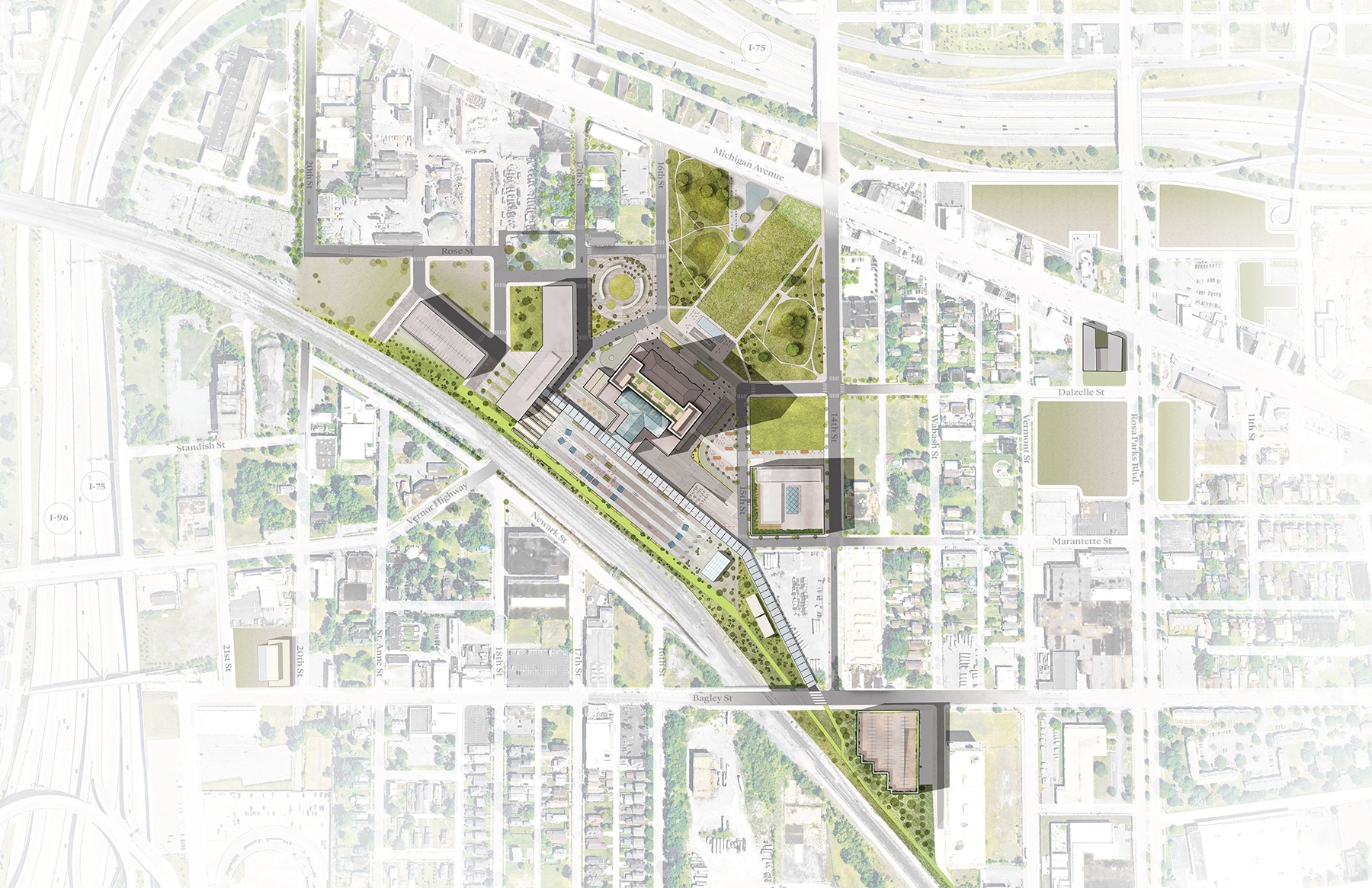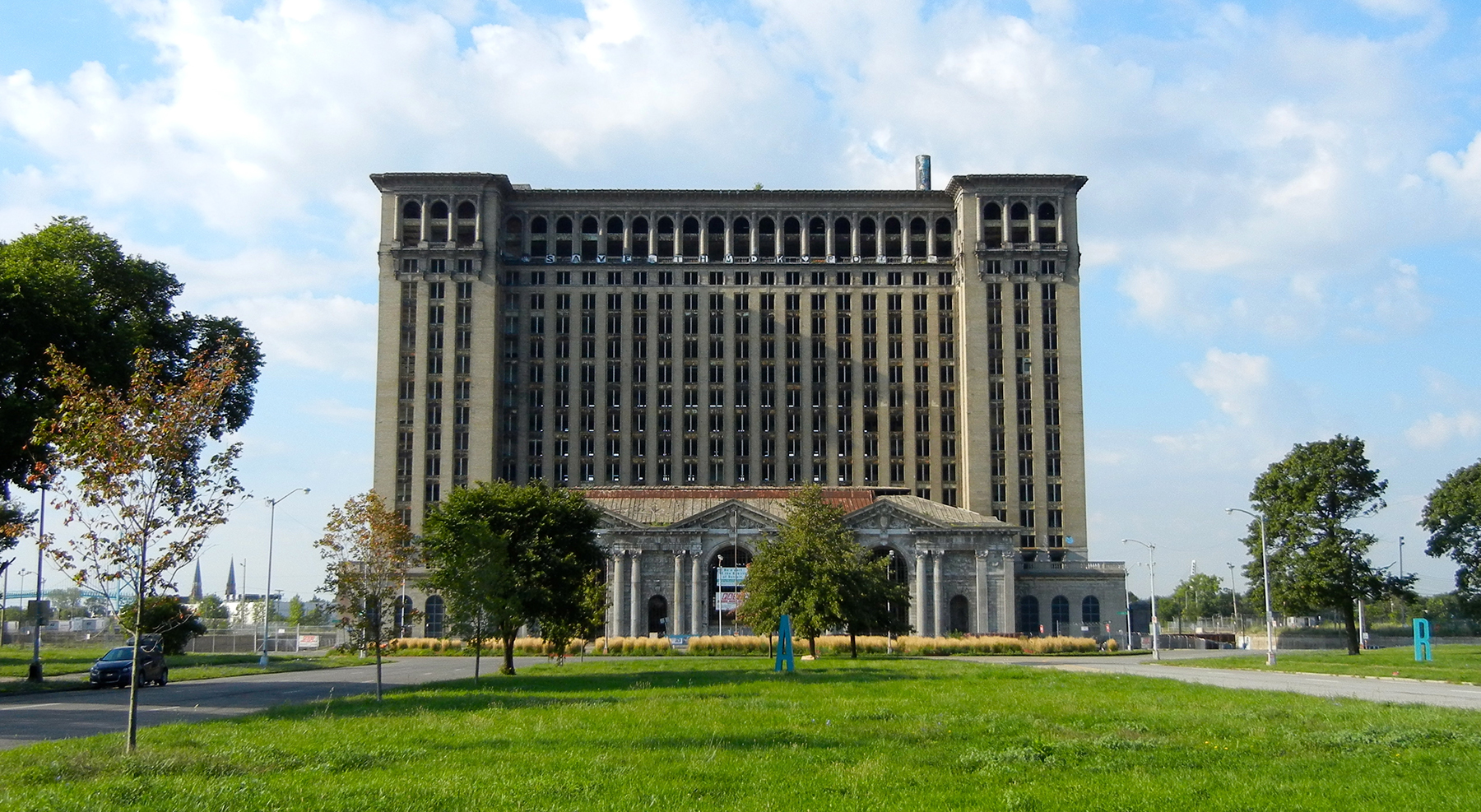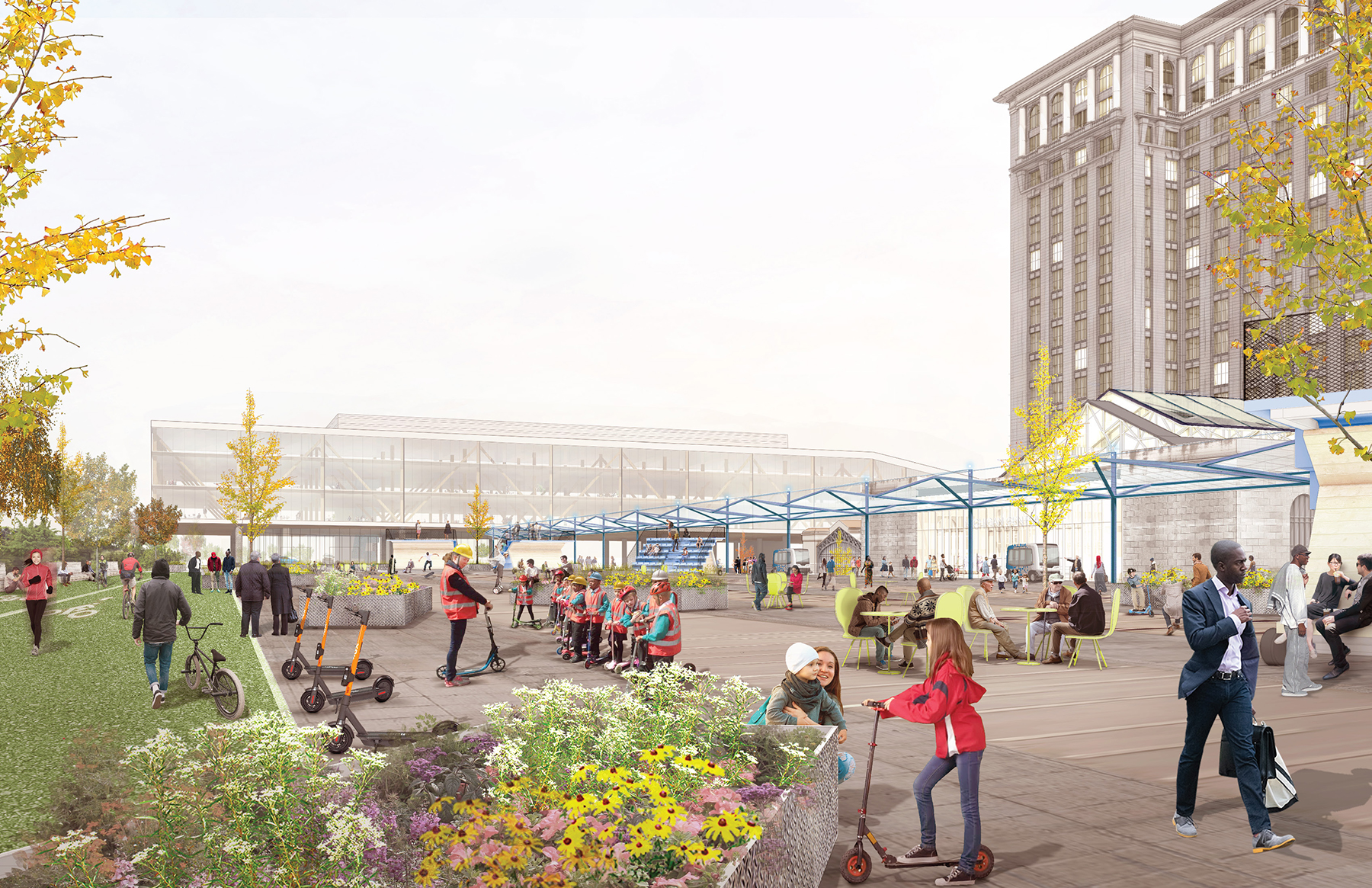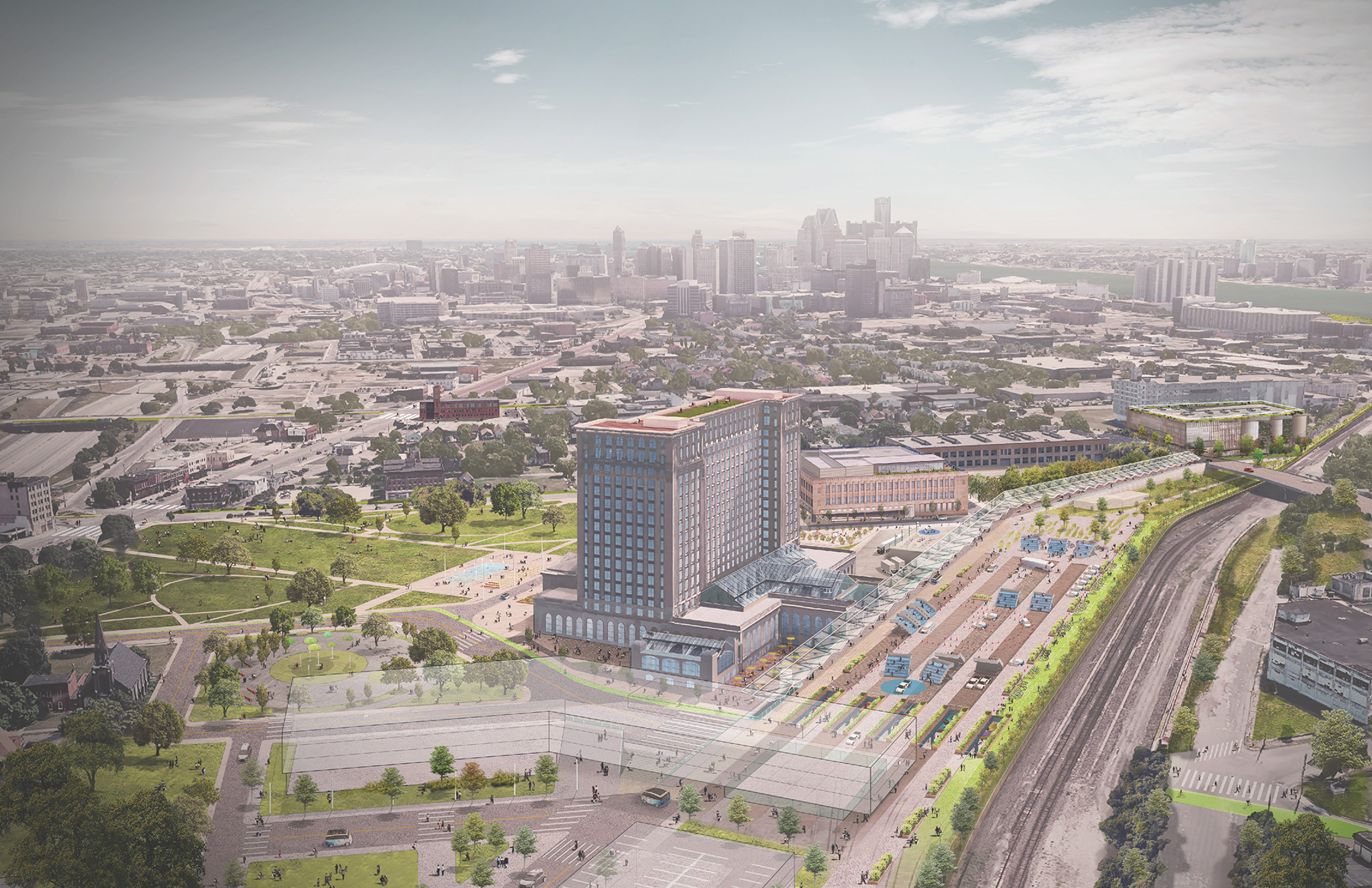By Robert L. Reid
Structural work to renovate and restore the 18-story tall, abandoned railway station complex in Detroit known as Michigan Central Station was substantially completed by the end of 2021, says Jenna Bresler, P.E., an associate and director of the Ann Arbor, Michigan, office of Silman, now part of the global engineering firm T.Y. Lin International.
The project is the centerpiece of a planned mobility innovation district being developed by Ford Motor Co. in the Corktown neighborhood of Detroit, southwest of the city’s downtown. Silman is the structural engineer and engineer of record for the project.

Known as Michigan Central, the overall project will encompass a 30-acre, walkable site that will welcome “mobility innovators and disruptors from around the world (to) develop, test, and launch new urban transportation solutions,” according to the project website.
In addition to the 640,000 sq ft beaux-arts train station building — which is expected to serve as commercial and event space — the Michigan Central project will also feature what Ford describes as “a first-of-its-kind mobility testing platform” that will be located on the 7-acre site of former elevated railway tracks on the southern, or back, side of the station. There will also be multiple outdoor plazas, open spaces, and 1.2 million sq ft of commercial space, including retail, restaurants, and hospitality.
An estimated 5,000 employees will eventually work in the innovation district, which will also include a restored structure known as the Book Depository building, adjacent to the station building, which will house a mixed-use makerspace, studios, and laboratory spaces; the Bagley Parking Hub, which will provide 1,250 parking spaces and serve as a mobility hub for other transportation options such as electric bikes and scooters; and a former textiles factory that is being repurposed to house members of Ford’s autonomous vehicle business and operations team.
The New York City-based architecture firm Practice for Architecture and Urbanism is leading the design of the Michigan Central mobility innovation district site plan. The Detroit office of the architecture firm Quinn Evans is in charge of the station building preservation work.
The international engineering firm Buro Happold is responsible for the project’s transportation design and mobility planning support, especially for the mobility testing platform; Buro Happold is also providing mechanical, electrical, and plumbing systems services for the station building.
Detroit-based Giffels Webster is the civil engineer, and Mikyoung Kim Design, of Boston, is the landscape architect for the site. A joint venture of the Christman Co. and L.S. Brinker, both based in Detroit, is the construction manager for the station renovation.
The renovated station and other features of the project are expected to open during 2022, with some aspects of the new district opening in 2023, according to Ford’s timeline.
Assessing the structure
When Silman engineers joined the project in summer 2018, the century-old station building had been abandoned for roughly 30 years. Water infiltration — at the various roof levels of the complex and up through the ground — as well as other natural factors and even vandalism had caused so much damage to the steel-framed structure with concrete slab floors that some spaces were unsafe to even walk around in, notes Bresler. It took the contractors a couple months just to remove damaged interior ceiling elements or unsecured exterior brickwork that might fall onto people examining the site, she explains.

Once it was safe enough to explore the station building, Silman’s team found structural conditions that ranged from good to significantly deteriorated, Bresler says. Using various testing measures — from ground-penetrating radar and steel coupon samples to load-testing of the floors using sandbags and wooden tubs filled with water — the engineers and contractors determined where the structural systems had to be replaced, where they could be reinforced with steel plates or angles, and where they retained sufficient inherent capacity to accommodate the planned new programs with just minor repairs, Bresler says.
The roof areas were among the most heavily damaged, especially in locations where water had pooled and the drainage systems were clogged, Bresler says. Elsewhere, the steel supports for a large system of skylights remained in good condition because even though the steel had been exposed to the elements for years, the rainwater had been able to drain, which meant the supports dried out after each storm. And while the floor slabs tended to be thin — just a few inches of concrete reinforced only by steel mesh — the tests proved that sufficient capacity remained even when small sections of concrete had disappeared, Bresler notes.
In what had once been a series of beautiful vaulted ceilings covered in thin Guastavino terra cotta tiles, Silman also worked with Quinn Evans and Jablonski Building Conservation Inc. and EverGreene Architectural Arts, both based in New York City, to map the location and condition of each tile, determine how well the tiles were anchored in place, and decide what — if any — structural reinforcement was needed to refurbish and reuse the decorative ceilings, Bresler says.
Silman also analyzed the existing concrete mat foundations that ranged in thickness from 2 to 4 ft; during this work, certain underground crawl spaces were discovered that had not been listed on the original structural drawings, says Bresler. Some of these spaces will be used to run new utilities, and others will be capped off. Although the project is not significantly altering the foundations, new foundational elements are being added to the mat slab to accommodate new elevator pits, she notes.
On the station’s exterior, Silman helped assess and repair the brick cladding on the station’s tower as well as the stone base and balustrade around a waiting room on the north side of the structure. In addition, the terra cotta detailing near the top of the tower was assessed and either secured with better anchorage or replaced with glass-fiber reinforced plastic elements.
Managing mobility
The mobility innovation district planned for the Michigan Central project will involve actual, physical spaces and a conceptual approach to how people move, communicate, and socialize within those spaces, says Francesco Cerroni, an associate principal and the head of North American mobility in Buro Happold’s New York City office.
The project’s physical spaces will include the new mobility testing platform that will be constructed on the site of the former elevated railway tracks, which will be demolished, says Cerroni. Intended as a test bed for various mobility technologies, including autonomous and connected vehicles, the new steel-framed platform will feature a dynamic and modular design that can be adapted to changing conditions and demands on a seasonal, weekly, or even daily basis, Cerroni says. Likewise, a section of nearby 15th Street has been closed and will serve as a shared space that will prioritize access for pedestrians, bicyclists, and so-called micromobility approaches — such as electric scooters — and a fleet of Ford’s autonomous and connected electric minibuses.

The transportation research and efforts planned within the mobility district will focus on providing the last-mile/first-mile solutions for people’s mobility needs, Cerroni says. This work will include the establishment of a network of micromobility hubs throughout the district that feature electric bikes and scooters, charging stations, and the potential for “seamless integration” between the mobility district’s transportation systems and the existing Detroit transit systems, Cerroni explains.
A new passenger rail station is also being discussed for the area adjacent to the mobility platform. Ford is in discussions with Amtrak and Canadian rail service providers, Cerroni adds, which could eventually restore “local, national, and even international passenger services” to the site.

In planning the mobility district, Buro Happold’s engineers conducted various studies and simulations on traffic impacts, road design, parking strategies, and even the pedestrian floor of people moving into and out of the Michigan Central Station building. Relying on an in-house software system known as SmartMove, Buro Happold’s engineers modeled “how the ground floor of the building will function in terms of location of accesses, the internal location of elevators, security screening procedures” and other factors “to provide a comprehensive assessment of the best way for people to flow inside and outside the building,” Cerroni explains.
A new concept for street design called dynamic lanes will also be implemented in the mobility district, Cerroni says. Developed by Buro Happold, the approach “shifts the paradigm of street design from providing circulation for vehicles to creating a space for citizens to move and gather in line with the principles of equity, safety, and accessibility,” he explains.

To achieve those goals, the street space will be divided into linear modules that can change depending on changing demands. For example, the dynamic lanes can be used for vehicular circulation during peak hours of the workday, prioritizing more sustainable modes such as transit. During off-peak hours, one or more lanes can be used as “smart curbs” to pick up and drop off of visitors to the district as well as for on-street parking and deliveries. At night and during the weekend, some of the same lanes will be accessible only to micromobility transportation methods, Cerroni says, and other lanes can be converted to public gathering spaces for events, outdoor seating, and food trucks.
The implementation of the dynamic lanes will be achieved through a combination of high-tech solutions such as dynamic signage, sensors, and technologies that allow communication between vehicles and the street infrastructure, Cerroni says. But low-tech solutions will also be involved, including the use of street furniture, markings, wayfinding, and different paving colors and materials.
Moving autonomously
The mobility district is also being considered as part of a planned connected and autonomous vehicle corridor from Detroit to Ann Arbor, Michigan, that will feature dedicated lanes for self-driving vehicles. The project is being led by Cavnue — a technology company with offices in Detroit; Arlington, Virginia; and Mountain View, California — the Michigan Department of Transportation, and the international engineering firm AECOM. Ford is also a partner in the project.
In an Oct. 28 press release, AECOM noted that the Michigan corridor will feature “a first-of-its-kind roadway infrastructure stack with a unique hardware and software product to simplify the operating environment for all vehicles and to provide more information to vehicles about the road ahead, both of which unlock the powerful benefits of in-vehicle technology.”
Cavnue is evaluating “the feasibility of a connected automated vehicle lane on both Interstate 94 and Michigan Avenue” in Detroit, notes Mark de la Vergne, the firm’s vice president of project development.
Testing will likely begin this year at the American Center for Mobility, in Ypsilanti, Michigan, as well as on public roads in the state, de la Vergne says.



